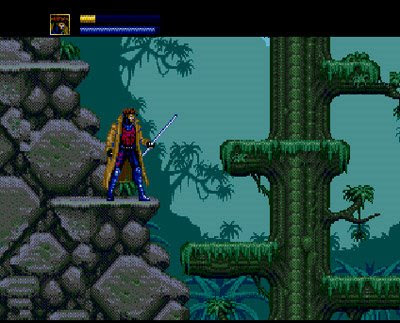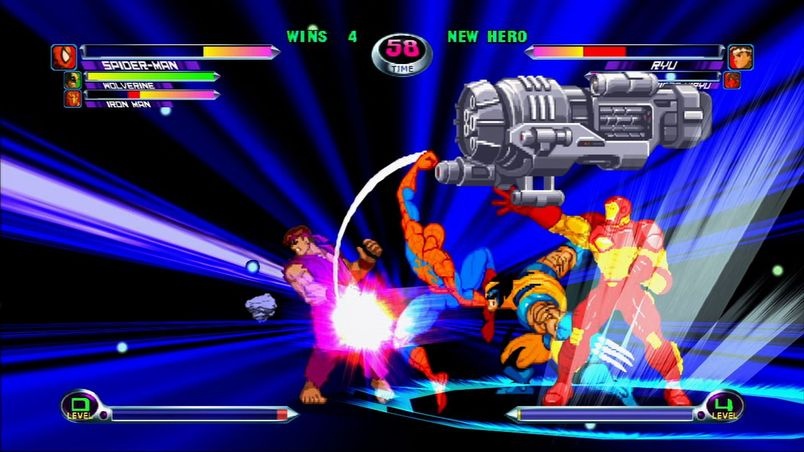Trending
Opinion: How will Project 2025 impact game developers?
The Heritage Foundation's manifesto for the possible next administration could do great harm to many, including large portions of the game development community.
This is an analysis piece on Super Hero video games. What has been good, what has been bad, and where do developers need to go in these games?

Super Heroes in Games
People love comic book heroes because of their extraordinary abilities. Super strength, flight, gadgets, laser vision or telekinetic powers are a major allure of comics. Video Games are an exceptional means to deliver fans the Super Hero Experience.
On Eurogamer.net, Comic book legend Stan Lee had said this to say about games and their developers:
"I marvel at the fact the games look as good, and in some cases better, as the most expensive movies," he said. "[Those] guys are just geniuses. Now you watch one of these games and it's like watching the greatest superhero movie, except you're part of it. It's indescribable."
Stan has essentially identified what is so appealing about the idea of the Super Hero Experience. The player is participating in the action, instead of reading about it or watching it on screen.
In an article on Kotaku, Lee further elaborated his point.
"But a videogame in a way is more imaginative, it has more variety. In a movie you stick to the plotline, in a videogame you go in a million different directions. I have no idea how they're able to do that. It's like a miracle."
The quote was then followed by this:
Know what's an even bigger miracle? When they make good games.
Video games and comics should be a match made in nerd heaven. However too many times games have failed to deliver the Super Hero Experience to the player. Growing up I remember being disappointed by countless video game adaptations of my favorite heroes. Developers and publishers are starting to figure out that these characters deserve a better shot at greatness in games, but how should they approach it? I'll list some examples of how they have failed, how they have succeeded and ultimately how they should move forward in my humble nerd opinion.
Stick to brand and make them epic!
The X-Men game on the Sega Genesis was guilty of what I call the Kryptonite Design Effect. This occurs when the hero in comics is normally quite powerful, but due to design choices, has had their abilities stripped. There has never been a point in comics or movies where Cyclops shouts "I can't shoot awesome laser beams out of my eyeballs anymore! Maybe I should wait and it will regenerate!" He has a constant stream of hurt coming out of his skull. So why shouldn't the game allow him to have that as well? Players want to feel like they are controlling someone powerful, it is part of the allure. Limiting the reason that people like these characters is going to negatively affect a fan's expectation of the Super Hero Experience.

Gambit in 16 bit
On the other side of the spectrum, Batman: Arkham Asylum allowed players to actually become Batman. The game designers gave the player Batman's abilities and best known attributes. Stealthily hanging bad guys gargoyles, seamlessly combating dozens of thugs at once and utilizing infamous bat gadgets were major tenants in the design.
The game from a design perspective also introduced the key components over time to becoming more epic. Batman didn't start out with all of his gadgets or moves due to the circumstances in the story line. However he could still use some gadgets and fight multiple enemies. As the game progressed he earned them slowly and allowed the player to grow and become more powerful. The key here is, he started out awesome, and over time he became more advanced in crime fighting. By playing more, the player begins to become more like the Dark Knight.
Marvel Vs. Capcom and the X-Men fighting games also did a great job of doing this as well. Rogue could hit hard with no limits and Gambit could throw as many charged kinetic cards as he pleased. They also had the super combo moves which allowed players to unleash a super move that built up after they landed hits or received damage. The already powerful characters unleash an exorbitant amount of power. The limiting factor is the player's willingness to learn moves, not the Kryptonite Design Effect.

Marvel Vs. Capcom 2
A common counter point to giving the player too much power 'Well then the game will be unbalanced, you'll have someone that is too powerful with no challenge.' Perhaps if the game is based off of tiny weak enemies that would be the case. Maybe these powerful heroes should fight powerful foes?
Evil-doers should be persistently evil and equally as powerful.
Too many times in games powerful super heroes have to combat hundreds of faceless enemies. When a person reads a comic it is often because the main character fights an epic battle with a powerful foe. In Superman vs. Doomsday, Superman fights him throughout MULTIPLE comic issues. It was one of the best selling graphic novels in the past twenty years.
This was not because Superman fought 300 little aliens, robots or any other sort of easy to deal with fodder. It was because Doomsday was one tough hombre and only the Man of Steel could take him down. Yet we don't make games like that. Why can't we fight one epic battle of Superman Vs. Doomsday throughout the outskirts of Metropolis and conclude in front of the Daily Planet?
EA's Superman is a big offender of the faceless enemy. Hundreds of aliens, mutants, and robots are hardly a real threat to Superman. The most powerful hero in the DC universe is reduced to fighting c-list enemies throughout the game. Superman should be fighting more powerful, threatening and vile super villains.

Superman Returns
Now this is not to say there should not be smaller enemies. Usually super villains have thugs and henchmen at their disposal. They should be an appetizer prior to a meal of a monumental show down. Learn the moves on the little guys so the player can use those skills on the big guys.
While the Wolverine Origins game featured numerous faceless enemies, it also leveled up players to prepare them for large scale boss battles.
One of the best super villain battles in the game was Wolverine Vs. Sentinel. This was a multi-stage boss battle. There were different sections and parts that added up to an excellent Wolverine experience. Fighting on the ground, in air, and all over the monstrosity made it feel like a real challenge because of the time invested into taking down one enemy, and using numerous skills utilized to finally succeed.
Sandbox Superheroes
With the rise it's meteoric rise popularity, Grand Theft Auto 3 had numerous developers wanting to emulate the feeling of freedom with Superheroes. Superman, Spider Man, Iron Man , etc., all have sand box based games. However successful sandbox games (like the GTA and Saints Row series') had ample amounts of time to develop the technology and design to ensure a great experience.
However games like Superman, Spider-Man and Iron Man are often plagued with bugs and issues. Often these titles are tied to a movie release so development time is shortened drastically. Undertaking a sandbox game with a movie release date is quite a feat to undertake considering the sheer size of a sandbox style game, let alone the powers and their effect on the gameplay in a sandbox.
One major super power design issue is flight control. Not all sandbox games have to deal with flight and can focus with driving and running around the city as a means of transportation. Adding flight is a huge mechanic to undertake. It's a whole new game to design when there is already a HUGE game that has other areas to worry about. Let alone adding other mechanics like combat with flight.
Spider-Man 2 and every other Spider-Man game thereafter on major consoles seemed to do a good job of getting the web slinging feeling down. It's always fun free falling through the air and then shooting some web to catapult spidey to greater heights. However the boss fights and the enemies seem lack luster because the focus of the game seems to be web slinging. Bosses seem glitchy and rushed. While the faceless thugs fall into the same repetitive melee/web shooting combat. Find what effectively clears the area of bad guys and repeat.
An effective example of making a great sand box game is boiled down to this:
If this game were to be linear, would it still be fun? The mechanics need to be the guiding factor to answer this question. Super powers, flying, melee combat etc. If they are not fun in a linear environment, why would they be in a vast and expansive environment?
One of the few sand box Super Hero type games that did seem to work exceptionally well was InFamous. The game developers understood that powers were the core of making the game fun. The protagonist Cole starts out with some basic powers and by the end of the game, he is a force to be feared. He can scale most buildings, hover, electrocute etc and most importantly the player can effectively control these commands.

Infamous
This is somewhat of a shooter as well, allowing the player to control WHERE they want to direct their powers. Too often in Super Hero games, the computer decides for the player with auto targeting. The difference here between the other games, is that in a linear environment, this game is still fun. However for the other games, it would likely be seen as mediocre depending on the title.
Where do we go from here?
Looking at the successes and mistakes of comic book games in the past, where should they go next?
• First and foremost, the game creators should understand and hopefully love the license. Fans of comics are more likely to understand what makes them interesting and can develop ideas based on the property. The developers on Batman Arkham Asylum and Wolverine Origins were adamant fans of the characters and it shows in their games. They created mechanics that were based on the heroes characteristics and they were memorable as a result.
• Create scenarios that are similar to the stories that the fans love. Fighting the Vulture as Spider-Man fifty stories up was a great fight in Web of Shadows. However blowing up hundreds of faceless drones repeatedly in Iron Man, was not as entertaining. Larger, well known villains should populate more game time as they are the exciting. Thugs and henchmen are always welcome adversaries but don't over do it on the nameless enemies.
• Do not create limits that are not in the comics. Storm should be allowed to summon a tornado whenever she likes, without an energy bar saying she doesn't have enough power. The game should be designed to provide a challenge around this ability.
• Understand time constraints and outside limitations that may affect development. Marvel has recently been developing games with movie tie-ins but are not directly related to the movies events. This way the game is not limited to, or dependent on, another area for approval.
• Sandbox games can be well done, but they need to have the time to make sure the tech can keep up with the gameplay. If the gameplay is fun in a linear fashion, it should make the transition to the sandbox.
The characters and stories deserve great gameplay to create powerful moments for fan interaction with their favorite super heroes. Hopefully developers can learn from the successes and failures of past games and continue to move towards greater licensed Super Hero games. 'Nuff said!
Read more about:
BlogsYou May Also Like